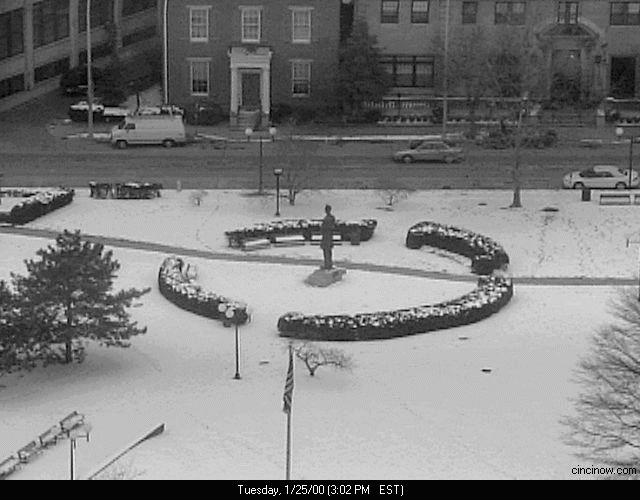

The image above is an animated gif of 4 frames from a web camera sequence (see Cincinnati images) provided by Ohhyun Kwon (Winter 2000). These images can be downloaded from skycamlg.zip (258 KB).
The horizontal bands running through the image are typical of NTSC camera images. This type of noise is the result of aliasing between the 60Hz refresh rate of the camera and the 60Hz power line frequency used in the United States. Thanks to Bob Clodfelter (Summer 1998) for his use of animated gifs to illustrate this phenonomenon.
Here are two ways of creating an motion image sequence using Matlab. The first uses the immovie function:
f1 = imread('skycamlg2.jpg');
f2 = imread('skycamlg3.jpg');
f3 = imread('skycamlg4.jpg');
f4 = imread('skycamlg5.jpg');
f1 = rgb2gray(f1);
f2 = rgb2gray(f2);
f3 = rgb2gray(f3);
f4 = rgb2gray(f4);
frames = cat(4,f1,f2,f3,f4);
mov = immovie(frames,gray(256));
movie(mov,50);
The second uses the function im2frame and can create RGB sequences.
f1 = imread('skycamlg2.jpg');
f2 = imread('skycamlg3.jpg');
f3 = imread('skycamlg4.jpg');
f4 = imread('skycamlg5.jpg');
f(1)=im2frame(f1);
f(2)=im2frame(f2);
f(3)=im2frame(f3);
f(4)=im2frame(f4);
movie(f,50);
There are actually five frames in the sequence provided by Ohhyun. Add the final frame to the sequence, as shown below, and observe what happens.
» f(5)=im2frame(imread('skycamlg6.jpg'));
» movie(f,50);
See cin_seq_full.gif for the result.
Maintained by John Loomis, last updated 4 Feb 2000